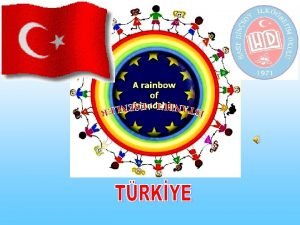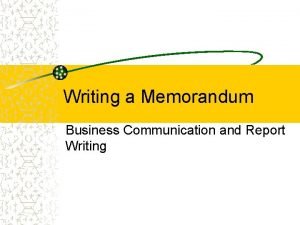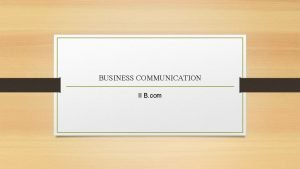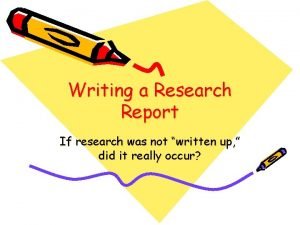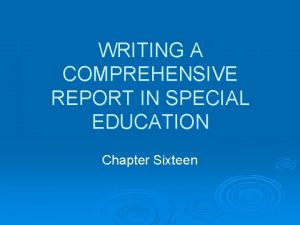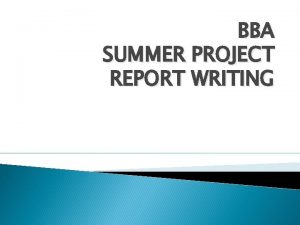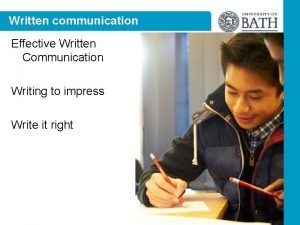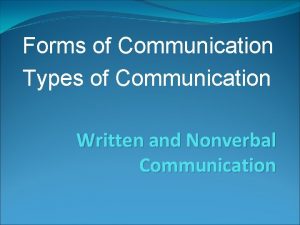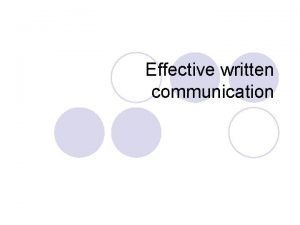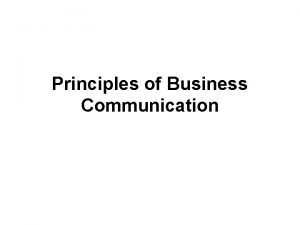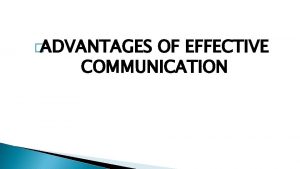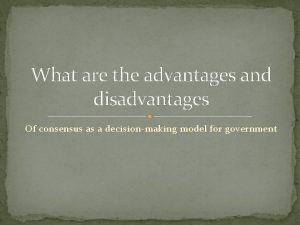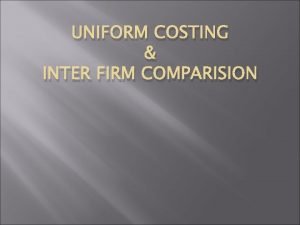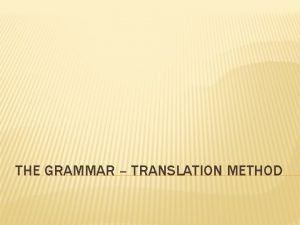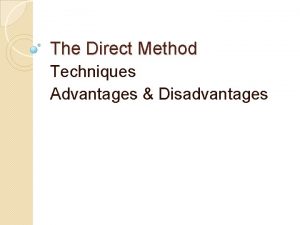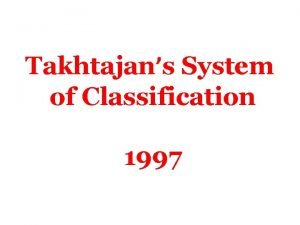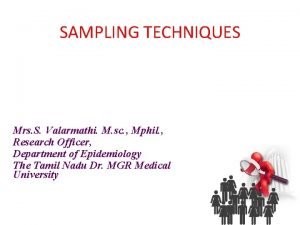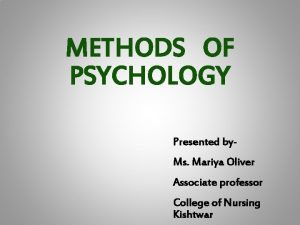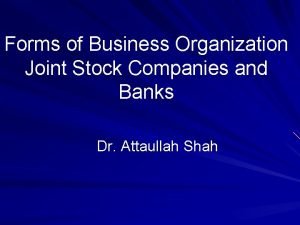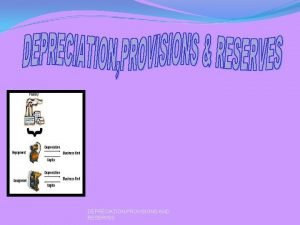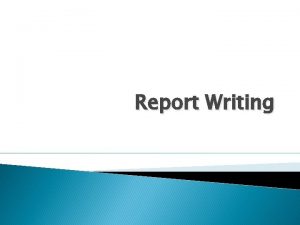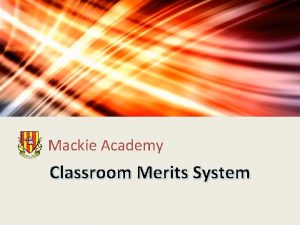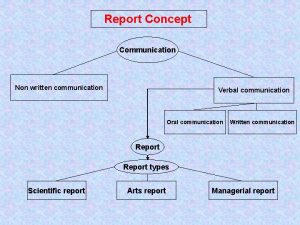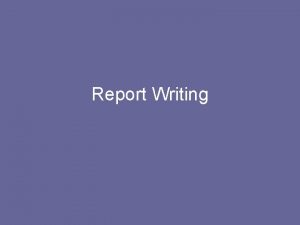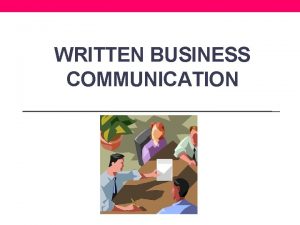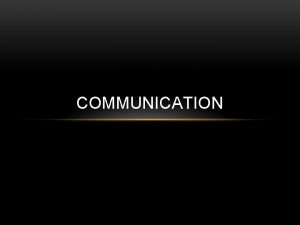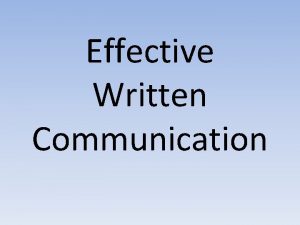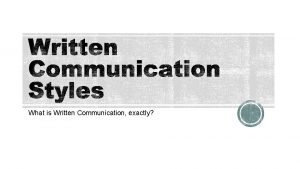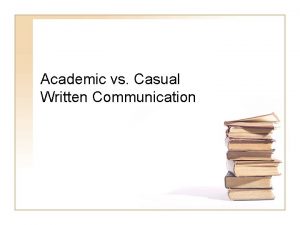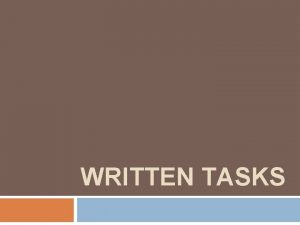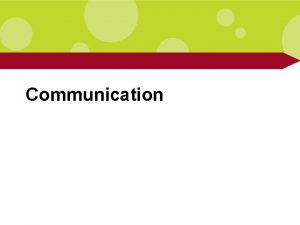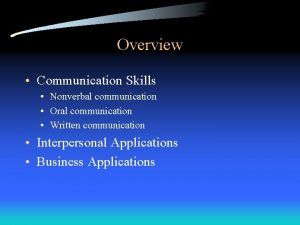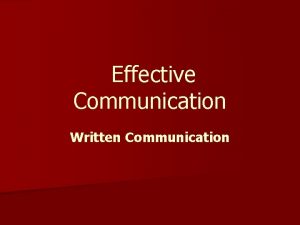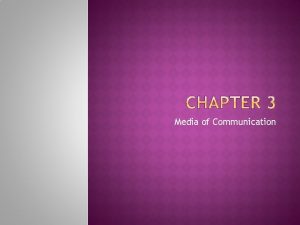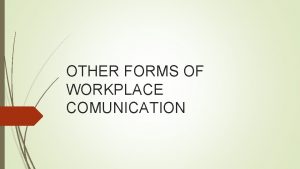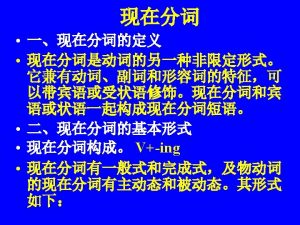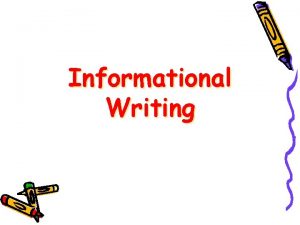Report Writing Merits of written communication It lasts































- Slides: 31

Report Writing

Merits of written communication � It lasts � Different forms � Serves many purposes � It can be properly organized

Report Writing � The word ‘report’ is derived from the Latin word “repot are” which means to carry back. � A report is the compilation of information that has been sought out, collected, sifted, organized, and written to convey a special message.

Benefits of reports �A communication tool: provide information to managers � Planning tool: past, present and future information � Controlling tool: appraisal and inspection information

Types of reports � Reports can fall in any of these categories: � PURPOSE ◦ Information reports: Present a record of previous events, to appraise progress and developments or to understand the situation. Eg: Compliance and regulations report. ◦ Analytical reports: Reports that provide data, analysis and conclusions. Writers sometimes also supply recommendations. These reports intend to persuade readers to act or change their beliefs. ◦ Compliance reports: Prompted by the government, compliance reports answers questions such as “how much profit did the organisation earn? ”, these reports comply with laws and regulations that protect employees, investors and customers.

◦ Justification/recommendation reports: When managers must justify or recommend something these reports are written. These reports analyse alternatives, interpret findings and make recommendations. They are important tools for managers in solving problems and making decisions. ◦ Yardstick reports: This report assesses the different alternatives available by applying the same criteria to each, such as cost, return and risk etc. ◦ Feasibility reports: These reports examine the benefits and problems connected with the project as well as its costs and schedule. The emphasis is on whether to proceed with the venture. ◦ Research reports: Make scientific enquiry of events, attitudes and behaviors and supplies specialised information for managerial decision making.

◦ Proposals: These are of two types � 1. Business plan with a persuasive report that seeks to convince investors to fund a new company. � 2. Research proposal to persuade Client company or funding agency to accept and grant funds for undertaking the research project. ◦ Press reports: Companies use public relations to influence the general public through the mass media. Ex: Newspaper, Radio, Television etc.

� FREQUENCY 1. Periodical (Routine): A periodic report may be daily, weekly, monthly etc. It is a scheduled one. Ex: A progress report. 2. Special (Occasional/Situational): A special report as required by an occasion. Ex: A project report � MEDIA: 1. Oral: Face to face communication about the subject. Oral reports are short lived. 2. Written: A written report provides flexibility in reading, now or later, one or more times and skip or cover all the parts.

� STYLE: �Formal: �semi-formal: More commonly used in daily business settings �informal.

Formal Vs Informal Reports Factor Informal Form Memo or Letter or Email Letter and Text Length Short Long Organisation Less structured, parts may vary Structured, parts are defined Writing Style Natural, conversational Impersonal, factual Cost Inexpensive Expensive Writing mode Hand written or typed Typed or printed Appearance Casual, stapled Attractive, bound Use of graphics Seldom Frequent

Individual versus committee reports � Individual reports are mostly routine business reports. � Individual reports are mostly written in a prescribed form

Committee reports � These reports are prepared by more than one individual. � Generally a committee is formed to compile a technical/ research report which is complex in compilation �The issue is complex- multi-faceted �The issue is critical – having serious impact on the functioning of the organization �The issue is sensitive and affects many employees.

Steps necessary to make committee work constructively � Formation of committee � Specify subject and its focus � Provide facility for investigation � Encourage deliberations � Set up clear goals

Individual versus committee reports Basis individual committee Persons involved One More than one Functions /dept One More than one subject Simple Complex occasion Routine Special basis Activity Study and deliberation focus Job responsibility Terms of reference or objectives and hypothesis structure Designed format mostly structured Unstructured style Semi-informal Formal frequency Routine regular and scheduled Special, as and when needed Media tool Letter or memo Letter and text

Format of reports � Memo format : memorandum, popularly known as memo, means a note to assist the memory. For short informal reports that stay within organisations. � Letter format � Manuscript format (letter cum text form) � Printed forms

Memo format ◦ Essentials: �Name and title of the sender and recipient �Reference and data �Complimentary close �Signature Tips for memo reports: �use an informal, conversational style �For direct analytical reports , put recommendations first. �For indirect analytical reports, put recommendations last

Memo format sample

Letter format � Essentials: ◦ ◦ ◦ Company name Address Date , subject, and reference Inside address Attention line Salutation Subject Body Complimentary close Signature Indentification marks Enclosure

� Tips ◦ ◦ for letter reports Single space the body Double space between paragraphs Leave two blank lines above each heading Create side margins

Manuscript format � Letter cum text form � Use manuscript formal for long, complex or formal reports and proposals. � A covering letter or memo will be attached to it. � Elements of a manuscript: ◦ ◦ Terms of reference Methodology Findings recommendations

Annual report � Annual reports besides being mandatory , are also relevant information sharing and image building documents. � These reports detail the progress achieved by the organisation in the reporting period.

� A typical annual report has the following details ◦ ◦ ◦ ◦ ◦ Name and address of the board of directors Top management team Names of auditors Progress at a glance Performance highlights and working results Directors report Accounting policies adopted Balance sheet Profit and loss account Schedules to be annexed to the balance sheet Notes on account where ever necessary Auditors report Commentary on the financial statements Ratios and statements Remuneration paid to the top management Changes in the board Acknowledgements

Research writing � Types of research reports ◦ Academic research reports ◦ Business research reports

Basis Academic research (thesis) Business research (project report) Stimulus Research gap identified by survey of literature A situation with a problem or opportunity Purpose To extend the horizons of knowledge( basic research). To find new applications (applied research) To provide information base for decision making Outcome Addition to knowledge. Recommendations for future action. Directions for future research. Audience Examiners , researchers, policy makers and public Managers and policy makers

A research report � Research papers are organized so that the information flow resembles an hourglass in that it goes from general to specific and then back to general again. The introduction and literature review sections will introduce the problem and provide general information. The methods and results will provide specific, detailed information about this research project and the discussion/conclusion will discuss the findings in a larger context. Broadly a research report has: Prefatory parts � Text � Supplementary parts � Appended parts �


� � � � Title The title should be specific and indicate the problem the research project addresses using keywords that will be helpful in literature reviews in the future. Abstract The abstract is used by readers to quickly review the overall content of the paper. Journals typically place strict word limits on abstracts, such as 200 words, making them a challenge to write. The abstract should provide a complete synopsis of the research paper and should introduce the topic and the specific research question, provide a statement regarding methodology and should provide a general statement about the results and the findings. Because it is really a summary of the entire research paper, it is often written last. Introduction The introduction begins by introducing the broad overall topic and providing basic background information. It then narrows down to the specific research question relating to this topic. It provides the purpose and focus for the rest of the paper and sets up the justification for the research.

� � � Literature Review The purpose of the literature review is to describe past important research and relate it specifically to the research problem. It should be a synthesis of the previous literature and the new idea being researched. The review should examine the major theories related to the topic to date and their contributors. It should include all relevant findings from credible sources, such as academic books and peer-reviewed journal articles. Methodology The methods section will describe the research design and methodology used to complete the study. The general rule of thumb is that readers should be provided with enough detail to replicate the study. Results In this section, the results of the analysis are presented. How the results are presented will depend upon whether the research study was quantitative or qualitative in nature. This section should focus only on results that are directly related to the research or the problem. Graphs and tables should only be used when there is too much data to efficiently include it within the text. This section should present the results, but not discuss their significance.

Discussion/Conclusion � This section should be a discussion of the results and the implications on the field, as well as other fields. The hypothesis should be answered and validated by the interpretation of the results. This section should also discuss how the results relate to previous research mentioned in the literature review, any cautions about the findings, and potential for future research. � References/Bibliography � The research paper is not complete without the list of references. This section should be an alphabetized list of all the academic sources of information utilized in the paper. The format of the references will match the format and style used in the paper. Common formats include APA, MLA, Harvard and so forth. �


Characteristics of a good report � Factual � Comprehensive � Objective � Logical � Consistent � Concise � Clear � Reader oriented � Creative
 Characteristics of a good report
Characteristics of a good report Favole the honest woodcutter
Favole the honest woodcutter What is oral communication and written communication
What is oral communication and written communication Diff between oral and written communication
Diff between oral and written communication Visual communication advantages and disadvantages
Visual communication advantages and disadvantages Business communication and report writing
Business communication and report writing Importance of report in business communication
Importance of report in business communication Research written report
Research written report Comprehensive written report
Comprehensive written report Summer project report for bba
Summer project report for bba Objective of written communication
Objective of written communication Written communication in healthcare
Written communication in healthcare Types of communication written
Types of communication written Formal and informal communication examples
Formal and informal communication examples Effective written communication
Effective written communication Written communication skills
Written communication skills Written communication skills
Written communication skills Principles of business communication
Principles of business communication Advantages of written communication
Advantages of written communication Example of written communication
Example of written communication Disadvantages of consensus communication
Disadvantages of consensus communication Benefits of uniform costing
Benefits of uniform costing Grammar translation method principles
Grammar translation method principles What are the disadvantage of direct method
What are the disadvantage of direct method Diagram takhtajan system of classification
Diagram takhtajan system of classification Bilingual method meaning
Bilingual method meaning Convenience sampling example
Convenience sampling example Merits of parliamentary government
Merits of parliamentary government Demerits of introspection method in psychology
Demerits of introspection method in psychology Demerits of joint hindu family business
Demerits of joint hindu family business Causes of depreciation
Causes of depreciation Merits and demerits of questionnaire
Merits and demerits of questionnaire

